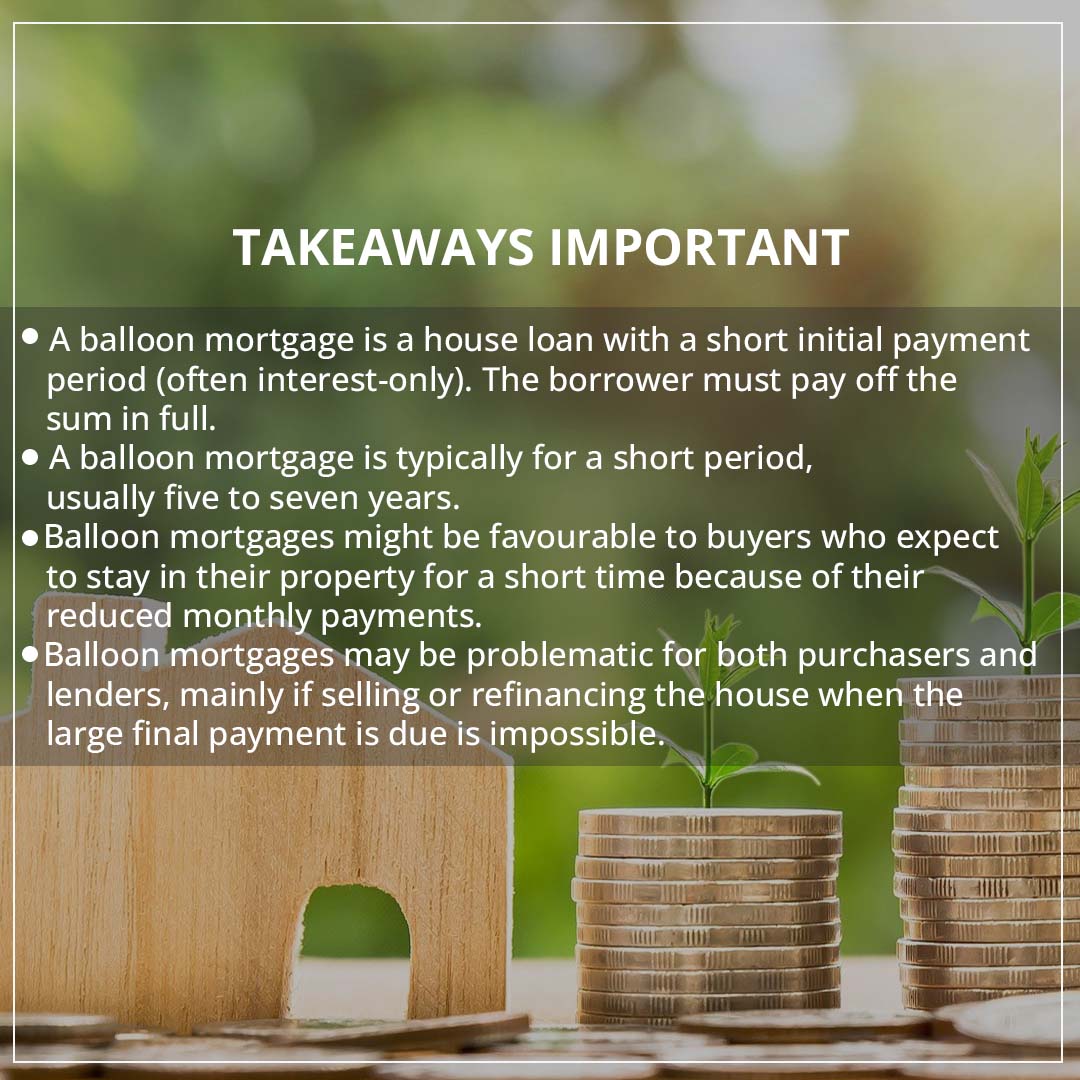A balloon mortgage is a real estate loan with a low or no monthly payment term that ends with the borrower paying off the complete total in one single sum. The interest rate given is frequently inadequate, and the monthly payments, if any, may be interested only.
Balloon mortgages offer short-term benefits, but they are dangerous for homeowners and lenders.

The Balloon Mortgage: An Overview:
Homebuyer balloon mortgages can be designed with a variety of terms and maturities, as well as fixed or variable interest rates. Some short-term loans may demand the borrower to return the principal and interest at the loan’s maturity, with no amortization during the loan’s duration. In others, a portion of the payments is applied to the principle, lowering it slightly. However, the majority of the amount is still due at the end.
Balloon mortgages can also include interest-only payments, allowing borrowers to make small monthly instalments before repaying the big sum when it’s due. Balloon mortgages can be given for as little as two years, although five to seven years is the most common duration.
The balloon payment mortgage is a variant of the balloon mortgage. The borrower pays a fixed interest rate for a specified number of years. The loan then resets, and the balloon payment is rolled into a new or continuing amortized mortgage at market rates at the end of the term. Balloon payments are usually at least twice as much as the loan’s prior instalments if not much more.
What Are the Benefits of a Balloon
Mortgage?

A balloon mortgage is an option for those who only plan to stay in their house for a limited time. Because it is paid off in a few years rather than 20 or 30 years like a traditional mortgage. It has minimal monthly payments and a considerably reduced overall cost.
Others might plan to stay there and refinance before the balloon payment is due. They may be anticipating a better salary by that time and are sure that they will afford a larger monthly payment. They may also predict a drop in interest rates.
A professional whose primary source of income is a year-end bonus is another sort of homeowner interested in a balloon mortgage. If the reward is assured, the buyer will move into the house sooner.
Business Loans with Balloons:
Businesses in the construction sector frequently utilize the balloon mortgage to acquire short-term funding for building projects without putting up any security. In this scenario, they are often short-term loans with higher interest rates than traditional collateralized business loans.
The building business may take out a year or 18-month loan and then refinance with a lower-rate mortgage, using the freshly constructed structure as security.
Balloon Payment Schedule Examples:
Let’s imagine you’re getting a $150,000 balloon mortgage for seven years. You only make interest rate payments of $531.25 per month. Those payments wouldn’t alter throughout the loan’s term, and neither would the amount owed on the mortgage. You would owe $150,000 after the period.
The Dangers of Balloon Mortgages:
The balloon mortgage is a risky investment.
First and foremost, the homeowner has little or no equity in the home and plans to sell or refinance it for at least the balloon payment amount. That may not be achievable in a slow or sinking real estate market. Even if it is, it isn’t a terrific option for the homeowner, who had planned to sell and go on.
If the housing market tanks, the borrower might be in danger. In the worst-case situation, the lender may or may not agree to extend the balloon payment date or amend the loan’s conditions.
Warning: Defaulting on a balloon mortgage, like any other mortgage, has significant ramifications: The home may be repossessed, and the borrower’s credit score may be severely harmed.
It may also be difficult to refinance the loan. Because the borrower has less equity in their property than they would with a traditional mortgage, they may appear to lenders as a less creditworthy possibility.
Lenders are also at risk with a balloon mortgage. Because the last payment is so large, the borrower’s chances of failing to make it and the lender having to foreclose on the property are higher. In addition, because the monthly payments are lower, lenders do not receive as much cash from the loan.
How Do I Pay It Off?

When it comes to paying off a balloon mortgage, borrowers typically have three options:
Put an end to it. The easiest solution is to pay down the outstanding debt in total if you can afford it. If you had planned when you took out the loan, you would have been saving and investing with this short-term time frame in mind. Or perhaps you anticipated a significant increase in your salary or the receipt of windfall money by this time (pension plan distribution, trust payout, etc.).
It should be refinanced. Pay off this loan by taking out a new one, most likely a more traditional fixed-rate loan with an amortization schedule. If you have a reasonable amount of equity in your house, a consistent income and/or other assets, and strong credit history, this plan will work for you. Keep in mind that your monthly payments will be higher due to this.
The house should be sold. Pay down the loan using the profits. Many people who choose balloon mortgages only intend to stay in their property for a few years—roughly the loan term—in any case. House flippers—those who acquire, refurbish, and sell homes—also employ balloon mortgages as a source of funding.











